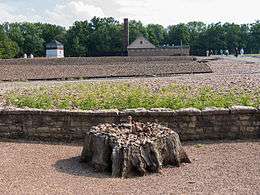Goethe Oak

Goethe Oak (or Goethe's Oak), is a name given to a number of oak trees in Germany that are referred to in this way because they allegedly bear some sort of connection to the poet Johann Wolfgang von Goethe.
History
Perhaps the most famous one is the oak tree near Weimar, Germany, on the Ettersberg, at the foot of which was the castle of Charlotte von Stein.[1] The oak, in the middle of a beech forest, is named thus because it is supposedly the tree under which Goethe wrote "Wanderer's Nightsong",[2] or, alternately, the location where he composed the Walpurgisnacht passages of his Faust. Quickly the fate of the oak became associated with the fate of Germany: if the one was to fall, so was the other.[1]
The end of the Buchenwald oak

The beech forest was cleared in 1937[3] to make way for the Buchenwald concentration camp.[1] Originally the camp was to be called KL Ettersberg ("KL" for Konzentrationslager), but this was abandoned because the Ettersberg name was so closely connected to the life of Goethe.[4] The tree stood in the center of the camp,[1] and is reputed to have served also for the hanging and torture of prisoners. The tree was hit by an Allied incendiary bomb on 24 August 1944 and burned all night long.[1] It is preserved (being cast in concrete under the auspices of the DDR government, which also placed a plaque saying "Goethe Eiche"[4]) and is part of the Buchenwald memorial.[3][5][6] For the SS guard and the prisoners the tree held two completely different meanings: for the SS it was a link to the Germany they thought they represented, but for the prisoners the tree pointed to a different Germany from the one they experienced in the camp.[7][8] According to Amos Oz, the incorporation of the oak in the camp and its subsequent destruction is evidence that the Nazis destroyed their own heritage,[9] and in Der Totenwald, camp survivor Ernst Wiechert recalls standing under the oak and reflecting on the two Germanies it represents—what later scholars would call the "Januskopfes Deutschland", the Weimar-Buchenwald dichotomy. The tree gave its name to another book by a survivor, Pierre Julitte's L'Arbre de Goethe (1965).[10] The oak was sketched by Léon Delarbre, who used to sit under its "charred limbs" and compose poetry.[11]
Other Goethe oaks
Another Goethe oak is in Krásný Dvůr Castle in Bohemia (today in the Czech Republic), estimated to be 1000 years old.[12] The Arnsberg Forest Nature Park in Sauerland claims one as well (a beech named for Friedrich Schiller fell victim to a storm in 2007[13]).[14]
References
- 1 2 3 4 5 Prisoner 4935 (4 November 2006). "Über die Goethe-Eiche im Lager Buchenwald". Neue Zürcher Zeitung (in German). Wojciech Simson (trans.). Retrieved 8 March 2014.
- ↑ Gorra, Michael (2009). The Bells in Their Silence: Travels through Germany. Princeton UP. p. 16. ISBN 9781400826018.
- 1 2 Young, Peter (2013-02-15). Oak. Reaktion Books. pp. 128–29. ISBN 9781780230597.
- 1 2 Aly, Götz (27 May 1999). "Goethe-Zeichnungen in Buchenwald, Porträts jüdischer Häftlinge im Schillermuseum: Vom Antlitz zur Maske". Berliner Zeitung (in German). Retrieved 8 March 2014.
- ↑ Cook, Christopher (11 July 2010). "Goethe's Oak". BBC Online. Retrieved 7 March 2014.
- ↑ "Goethe Oak". Buchenwald and Mittelbau-Dora Memorials Foundation. Retrieved 7 March 2014.
- ↑ Neumann, Klaus (2000). Shifting Memories: The Nazi Past in the New Germany. U of Michigan P. pp. 179–80. ISBN 9780472087105.
- ↑ Jacobson, Mark (2010). The Lampshade: A Holocaust Detective Story from Buchenwald to New Orleans. Simon and Schuster. pp. 9–10. ISBN 9781416566304.
- ↑ Oz, Amos (2009). The Amos Oz Reader. Houghton Mifflin Harcourt. p. 384. ISBN 9780156035668.
- ↑ Ziolkowski, Theodore (2001). "Das Treffen in Buchenwald oder Der vergegenwärtigte Goethe". Modern Language Studies (in German). 31 (1): 131–50. JSTOR 3195281.
- ↑ Jenkins, David Fraser (2000). John Piper: The Forties. New Age International. p. 84. ISBN 9780856675348.
- ↑ "The most beautiful Czech gardens and parks – Part 3 (Bohemia)". Hello Czech Republic. Retrieved 7 March 2014.
- ↑ Wessel, Stephan (19 July 2011). "Erkundung des Wanderweges Kurfürstlicher Thiergarten" (in German). Retrieved 9 March 2014.
- ↑ "Geschichte am Wegesrand - Wandern im Kurfürstlichen Tiergarten Arnsberg" (in German). Urlaub und Reise News. 19 July 2012. Retrieved 9 March 2014.
| Wikimedia Commons has media related to Goethe oak, Buchenwald. |